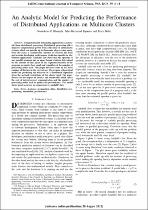 ResearchSpace
ResearchSpace
An analytic model for predicting the performance of distributed applications on multicore clusters
JavaScript is disabled for your browser. Some features of this site may not work without it.
- ResearchSpace
- →
- Research Publications/Outputs
- →
- Journal Articles
- →
- View Item
| dc.contributor.author |
Khanyile, NP

|
|
| dc.contributor.author |
Tapamo, J-R

|
|
| dc.contributor.author |
Dube, E

|
|
| dc.date.accessioned | 2012-09-17T09:53:41Z | |
| dc.date.available | 2012-09-17T09:53:41Z | |
| dc.date.issued | 2012-08 | |
| dc.identifier.citation | Khanyile, NP, Tapamo, J-R and Dube, E. 2012. An analytic model for predicting the performance of distributed applications on multicore clusters. IAENG International Journal of Computer Science, vol. 39(3), pp 312-320 | en_US |
| dc.identifier.issn | 1819-656X | |
| dc.identifier.uri | http://www.iaeng.org/IJCS/issues_v39/issue_3/IJCS_39_3_11.pdf | |
| dc.identifier.uri | http://hdl.handle.net/10204/6099 | |
| dc.description | IAENG International Journal of Computer Science, vol. 39(3), pp 312-320 | en_US |
| dc.description.abstract | Computationally demanding applications can benefit from distributed processing. Distributed processing offers immerse computational power from collections of autonomous systems which can provide up to thousands of processing cores. Over the years, a considerable amount of research has been put towards developing performance prediction models for distributed applications. Amdahl's law states that the speedup of any parallel program has an upper bound which is determined by the amount of time spent on the sequential fraction of the program, no matter how small and regardless of the number of processing nodes used. This paper discusses some of the short comings of this law in the current age. We propose a theoretical model for predicting the behavior of a distributed algorithm given the network restrictions of the cluster used. The paper focuses on the impact of latency and bandwidth which affect the cost of interprocessor communication and the number of processing nodes used to predict the performance. The model shows good accuracy in comparison to Amdahl's law. | en_US |
| dc.language.iso | en | en_US |
| dc.publisher | International Association of Engineers (IAENG) | en_US |
| dc.relation.ispartofseries | Workflow;9545 | |
| dc.subject | Multicore clusters | en_US |
| dc.subject | Amdahl's law | en_US |
| dc.subject | Algorithms | en_US |
| dc.subject | Propagation delay | en_US |
| dc.subject | Bandwith | en_US |
| dc.subject | Latency | en_US |
| dc.subject | Distributed programming | en_US |
| dc.title | An analytic model for predicting the performance of distributed applications on multicore clusters | en_US |
| dc.type | Article | en_US |
| dc.identifier.apacitation | Khanyile, N., Tapamo, J., & Dube, E. (2012). An analytic model for predicting the performance of distributed applications on multicore clusters. http://hdl.handle.net/10204/6099 | en_ZA |
| dc.identifier.chicagocitation | Khanyile, NP, J-R Tapamo, and E Dube "An analytic model for predicting the performance of distributed applications on multicore clusters." (2012) http://hdl.handle.net/10204/6099 | en_ZA |
| dc.identifier.vancouvercitation | Khanyile N, Tapamo J, Dube E. An analytic model for predicting the performance of distributed applications on multicore clusters. 2012; http://hdl.handle.net/10204/6099. | en_ZA |
| dc.identifier.ris | TY - Article AU - Khanyile, NP AU - Tapamo, J-R AU - Dube, E AB - Computationally demanding applications can benefit from distributed processing. Distributed processing offers immerse computational power from collections of autonomous systems which can provide up to thousands of processing cores. Over the years, a considerable amount of research has been put towards developing performance prediction models for distributed applications. Amdahl's law states that the speedup of any parallel program has an upper bound which is determined by the amount of time spent on the sequential fraction of the program, no matter how small and regardless of the number of processing nodes used. This paper discusses some of the short comings of this law in the current age. We propose a theoretical model for predicting the behavior of a distributed algorithm given the network restrictions of the cluster used. The paper focuses on the impact of latency and bandwidth which affect the cost of interprocessor communication and the number of processing nodes used to predict the performance. The model shows good accuracy in comparison to Amdahl's law. DA - 2012-08 DB - ResearchSpace DP - CSIR KW - Multicore clusters KW - Amdahl's law KW - Algorithms KW - Propagation delay KW - Bandwith KW - Latency KW - Distributed programming LK - https://researchspace.csir.co.za PY - 2012 SM - 1819-656X T1 - An analytic model for predicting the performance of distributed applications on multicore clusters TI - An analytic model for predicting the performance of distributed applications on multicore clusters UR - http://hdl.handle.net/10204/6099 ER - | en_ZA |





